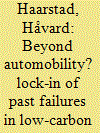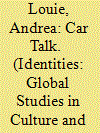|
|
|
Sort Order |
|
|
|
Items / Page
|
|
|
|
|
|
|
| Srl | Item |
| 1 |
ID:
186419


|
|
|
|
|
| Summary/Abstract |
Automobility, including the infrastructures, technologies and institutions that created high dependence on private car use, has led to significant environmental and climate problems and notably high carbon emissions. Now cities are attempting to move beyond this failed regime by experimenting with a range of different mobility innovations. In this paper, we examine whether emergent policy-led experiments and innovation processes in low-carbon mobility are learning from the past, or whether they are reproducing key elements of past policy failures. Through four case studies – Birmingham, Stavanger, Milton Keynes and Melbourne – we assess attempts to break out of high-carbon automobility through three key factors, namely diversification of travel options, a shift from individual to shared forms of mobility, and whether these aspects are implemented at scale. We find that while all cities show potential for diversification and sharing at scale, current modes of innovation exhibit features that may reproduce rather than reduce high-carbon automobility. Our analysis attributes this risk of continued failure to how policy-led experimentation and innovation are structured and themselves become locked in, thereby upholding the obdurate automobility regime.
|
|
|
|
|
|
|
|
|
|
|
|
|
|
|
|
| 2 |
ID:
164299


|
|
|
|
|
| Summary/Abstract |
The apparent conspicuous consumption of luxury vehicles by Chinese international students attending a public Michigan University provides an opportunity to examine the convergence of different ideas about automobility. Upwardly mobile Chinese families send their children to Michigan, a state with a tradition of auto-production, for educational opportunities not available in China. The resulting ‘car talk’ of local residents about Chinese students and their cars speaks to broader anxieties about Michigan’s shifting relationship to the global economy. However, the paper focuses on the meanings of auto-owning created by Chinese students who make decisions about the purchase and use of their autos within a social world oriented primarily to other Chinese students and societal ideas about auto-owning circulating among friends, family and society in China. For Chinese students, car owning encompasses meanings of status, safety and sociability that are created within the context of study abroad.
|
|
|
|
|
|
|
|
|
|
|
|
|
|
|
|
| 3 |
ID:
144171


|
|
|
|
|
| Summary/Abstract |
India’s post-liberalisation landscape has unexpectedly been populated by monumental iconic statues. These statues, co-emergent with an automobile and construction boom and an attendant resignification and revaluing of land, are a productive site for rethinking the role of spectacle in neoliberal globalisation from the locus of post-liberalisation India. Against theories that characterise spectacle as primarily virtual and deterritorialised, they illuminate how spectacle is enmeshed in the imaginaries, spatial politics, material processes and heterogeneous temporalities of uneven development. Their religious aspect also calls for a re-examination of Benjamin’s distinction between cult value and exhibition value.
|
|
|
|
|
|
|
|
|
|
|
|
|
|
|
|
| 4 |
ID:
187762


|
|
|
|
|
| Summary/Abstract |
Cars are a central means by which socio-political information is communicated in Lebanese public space, as is the case in other car cultures around the world. In Lebanon, cars are used to perform and reproduce structures of power within the country’s social hierarchy. In recent years, a highly developed system of automobile symbols and meanings has emerged and driving on the Lebanese roads requires that drivers become fluent in this ‘grammar’ of power. This article reconciles the anthropological ‘turn to the state’ with a growing body of literature on automobility in the Middle East and work on the roles of cars in social and political performance in a wide range of other cultural contexts. Following Mitchell’s theorisation of the ‘state effect’, this article argues that it is through this grammar, interpreted every day on the Lebanese roads, that state power is substantiated. However, Lebanese automobiles add a further layer of complexity to the ‘state effect’ by simultaneously drawing attention to the state’s fragmentation and impotency. They highlight other coexisting and competing systems of power. Lebanese drivers are disciplined in interpreting and acting on these signs on a daily basis. This article is an ethnographic account of the language of power embodied by automobiles. It gives a detailed analysis of the information conveyed by four main visual aspects of cars on the Lebanese road and explores the implications for understandings of statehood and power that emerge.
|
|
|
|
|
|
|
|
|
|
|
|
|
|
|
|
|
|
|
|
|